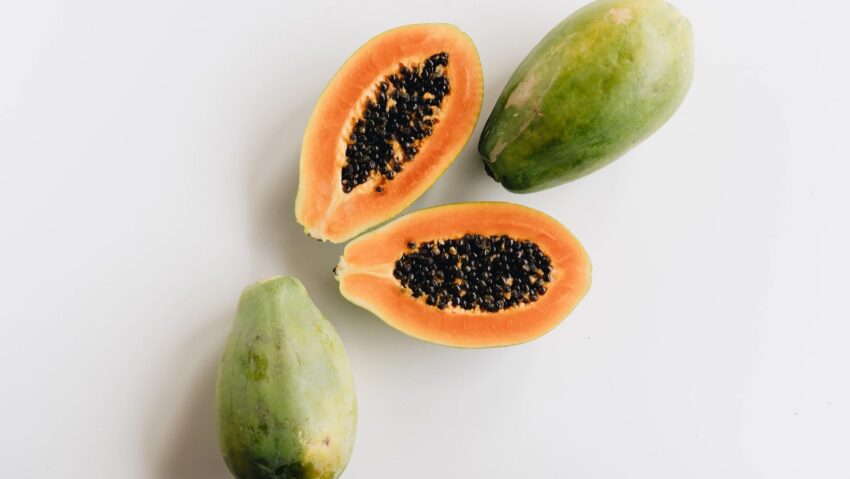How to Cut Papaya – Step by Step

While there are all different types of papaya or “pawpaw”, all of them are native to tropical regions such as Central and South America, Mexico, Hawaii. Local grocery stores near me carry Mexican papayas and the brand they had today was Chula Vista. They are large football shaped fruit, weighing about four pounds and are green when unripe. The inside can range from yellow to deep peach or bright orange flesh that has the texture of mango, with the sweet flavor of melon. They also have hundreds of black seeds inside which are normally removed, but don’t worry, they’re edible! Read on for how to cut papaya in different ways and why you want to do it!!
Table of contents
- How to choose a papaya at the store
- How do you know when it’s ripe?
- How to ripen papaya at home
- What you need to start cutting
- How to cut your papaya
- What does papaya taste like?
- What do you do with papaya seeds?
- How to serve papaya?
- How to store papaya?
- How does papaya fit into my macros?
- Papaya Nutrition
- References
How to choose a papaya at the store
In addition to Mexican papaya, you may also see Hawaiian papaya in the U.S. Either way, they will most likely be green, so just pick one that is heavy for it’s size with clean, unblemished skin. Ripe papaya should have a sweet aroma and papaya skin should hold an impression when squeezed gently. Handle gently to prevent bruising. And beware, fresh papaya will continue to ripen at home. Peak season is late Fall through early Spring. Though, like pineapple, in the US papaya are available and ready to eat year round.
How do you know when it’s ripe?
When you get it home, it will likely need a few days to ripen to a nice yellow color. Unripe papaya is green and should be stored in a cool dry place. I remember my grandfather wrapping it in newspaper and leaving it on the counter in the cool laundry room to become ripe at room temperature.
Papayas are kind of like bananas, where they’re not so sweet when they’re green, but they’re really enjoyable to eat when they’re deep yellow, even slightly spotted.
Papayas are best enjoyed when they are 3/4 yellow. Overripe papaya may blemish and develop soft spots. If this happens, cut it right away.
How to ripen papaya at home
Store green papaya wrapped in newspaper or in a paper bag in a cool dry place for 2-3 days until it is no longer green, and is turning yellow. The more yellow and spotted the papaya, the riper it is. Once it is ripe, or turning yellow, it should be cut. It can be stored in the fridge to stall ripening, if you’re not quite ready to cut it yet.
What you need to start cutting
- cutting board
- chef’s knife
- paring knife
- spoon
- optional: vegetable peeler
How to cut your papaya
- Remove the paper from your papaya
- Rinse under cool running water.
- Using a sharp knife, cut the papaya in half, longways.
- Then cut off the ends of the papaya.
- Using a large spoon, remove the black seeds and discard, or set aside to add to salad dressings for a peppery bite!
- At this point you can use a melon baller to scoop out kid friendly rounds!
- OR I like to use a chef’s knife to cut into long strips, about 3/4 inch thick. For me, this is the simplest method.
- Then use a paring knife to remove the papaya skin along with any black spots
- Then I either serve in strips or cut into smaller pieces.
I’ve seen people remove the skin of the fruit with a vegetable peeler, but it can be a little cumbersome. If you want to remove the skin before cutting the fruit halves, I recommend turning the “papaya boat” or half, upside down so the flat side is on the flat surface of the counter top so the slippery fruit is more stable.
What does papaya taste like?
Mexican papaya is firm and juicy, but not quite as intense as Hawaiian papaya, which are much smaller in size.
Papaya has a sweet taste similar to other melons and can have a musky flavor when overripe. If you don’t like the flavor of papaya at room temperature, you may like it chilled.
What do you do with papaya seeds?
The small round black seeds inside the papaya are actually edible! They have a peppery flavor and can easily be incorporated into salad dressings or marinades.
If that doesn’t sound good to you, compost them or discard.
How to serve papaya?
- Chilled with a little lime juice
- Chop it into a fruit salad with other tropical fruits such as mango and banana
- Papaya salsa made with red onion
- Use papaya halves as their own bowl! Fill them with tuna salad, fruit, yogurt or cottage cheese.
- Add papaya to salad
- Consider adding papaya to lunchboxes as an interesting and tasty addition
- Add to holiday fruit baskets.
- Add a papaya salad to your brunch spread
- Pair with grilled meat and seafood for a pop of color and balance.
- Add papaya to marinades to take advantage of their natural tenderizing properties
- Cut a papaya to pair with food from Indian cuisines
- Juice it or add to smoothies!
What flavors go well with papaya?
- meat
- poultry
- smoked meats
- avocado
- chilies
- lime
- lemon
- tropical fruits
- coconut
- ginger
How to store papaya?
- Store in an airtight container for several days in the refrigerator.
- Chunks can also be frozen. I recommend freezing them on a large sheet pan first. Then place frozen chunks in a zip lock bag, remove as much air as possible and then place back in the freezer for up to three months!
How does papaya fit into my macros?
- Just like most fruit!
- Make a mental note to fit it into your next regular or low macro days!
- Portion it out into 1 or 2 cup servings for an easy grab and go lunch!
- 1 cup : 16g Carb, 2g Fiber, 1g Protein, 1g Fat
Papaya Nutrition
Papaya is low in calories and rich in nutrients and has a lot of health benefits. List most fruit, they’re low in calories and a good source of fiber and other important nutrients.
Just one cup of pieces has…
- 62 calories
- 1g protein
- .5g fat
- 16g carb
- 2g fiber
- 29mg calcium
- 264mg potassium
- 53mcg folate
- 68mcg vit A
- 88mg vit C
- 3.77mcg vit K
- 2650mcg lycopene
And so much more!! 2
They’re high in vitamins A, C, K and folate, fiber and potassium!
They’re also rich in antioxidants carotenoids and phenols.
It also contains an enzyme called papain, which aids digestion.
Papaya was ranked first in a study that compared 40 different fruits for their Dietary Recommended Intake of nine vitamins, potassium and fiber.3
It’s combination of vitamins A and C, fiber and potassium make it a super heart healthy fruit.
Red flesh papaya fruit are a good source of lycopene which is an inactive source of Vitamin A that has been linked with reduced risk for lung, prostate and stomach cancers.1
References
- https://www.sciencedirect.com/topics/agricultural-and-biological-sciences/papaya
- https://fdc.nal.usda.gov/fdc-app.html#/food-details/169926/nutrients
- https://www.amazon.com/Dole-Nutrition-Handbook-Longer-Healthier/dp/1605292958




